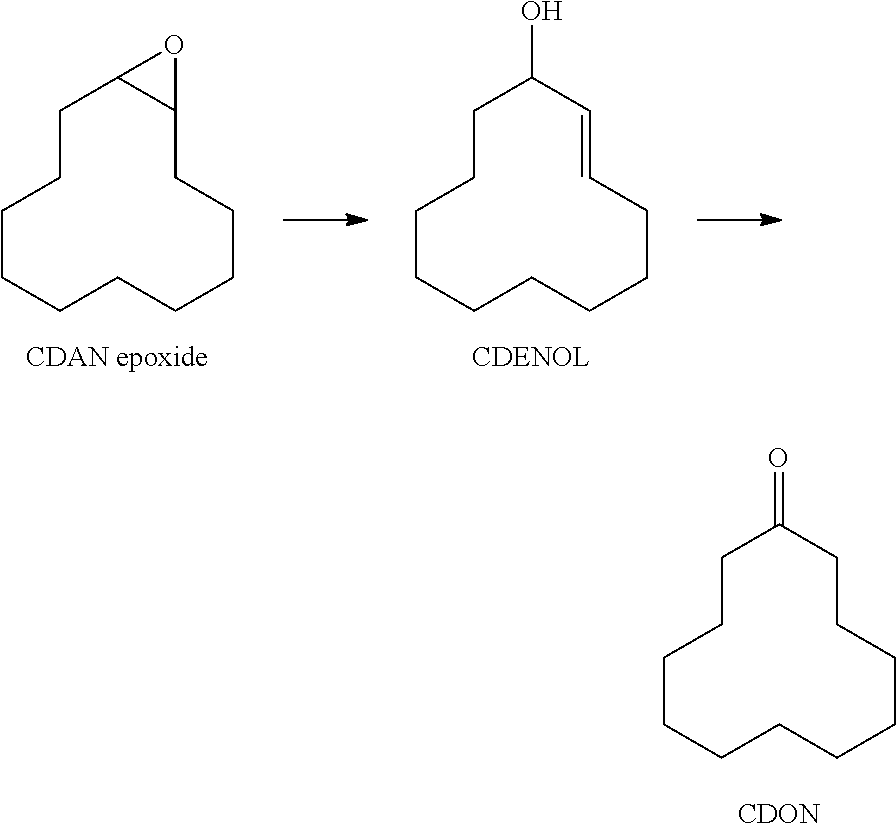Process for preparing ketones from epoxides
a technology of epoxide and ketone, which is applied in the field of process for preparing ketone from epoxide, can solve the problems of excessive reaction time, dehydration of dienes or dimers, and high reaction time of lower pressur
- Summary
- Abstract
- Description
- Claims
- Application Information
AI Technical Summary
Benefits of technology
Problems solved by technology
Method used
Image
Examples
example 1
Alumina Support (Conventional Method)
[0076]The reaction was conducted in a mechanically stirred 500 ml round-bottom flask. The reactor was heated with an electrical aluminium heating block and the internal temperature was monitored with a temperature sensor. The flask was charged with 50 ml of 1,2-cyclododecane epoxide and 10 g of catalyst, supported on alumina in the form of shaped bodies. The catalyst bed lay on the base of the flask and the liquid reaction mixture was stirred over the bed. The flask was subsequently inertized with nitrogen and heated to internal temperature 215° C. The temperature was maintained over 5 hours.
[0077]
TABLE 1Composition (area %, GC) of the reaction mixture (5 h)ConversionSelectivity (%)CatalystSupport(%)CDANCDENCDONCDOLCDENOLRu / Al2O3γ-Al2O3990.257171.31.5%Pd / Al2O3γ-Al2O31001475600.5%
example 2
Various Metals and Supports (Inventive)
[0078]The reaction was conducted in a mechanically stirred 500 ml round-bottom flask. The reactor was heated with an electrical aluminium heating block and the internal temperature was monitored with a temperature sensor. The flask was charged with 50 ml of 1,2-cyclododecane epoxide and 10 g of catalyst system III (noble metal supported on titanium dioxide or zirconium dioxide, each in the form of shaped bodies). The catalyst bed lay on the base of the flask and the liquid reaction mixture was stirred over the bed. The flask was subsequently inertized with nitrogen and heated to internal temperature 215° C. The temperature was maintained over 5 hours.
[0079]
TABLE 2Composition (area %, GC) of the reaction mixture (5 h)ConversionSelectivity (%)CatalystSupport(%)CDANCDENCDONCDOLCDENOLRu / TiO2Aerolyst ®89038640.61.0%7711Pd / TiO2Aerolyst ®930.4190300.5%7711Pd / ZrO2from900096300.5%Zr(OH)4350° C.calc.Pd / ZrO2t-ZrO2, 94(a)0.209430.30.5%8% Y2O3(a)30 g of cat...
example 3
Mixture of Catalysts (Inventive)
[0080]The reaction was conducted in a mechanically stirred 500 ml round-bottom flask. The reactor was heated with an electrical aluminium heating block and the internal temperature was monitored with a temperature sensor. The flask was charged with 50 ml of 1,2-cyclododecane epoxide, 10 g of supported noble metal (0.5% by weight of palladium on silica in the form of shaped bodies) and 10 or 20 g of metal oxide of the catalyst system (shaped bodies) (catalyst system II). The catalyst bed lay on the base of the flask and the liquid reaction mixture was stirred over the bed. The flask was subsequently inertized with nitrogen and heated to internal temperature 215° C. The temperature was maintained over 5 hours.
[0081]
TABLE 3Composition (area %, GC) of the reaction mixture (5 h)CatalystConversionSelectivity (%)(10 g)Oxide(%)CDANCDENCDONCDOLCDENOLPd / SiO2—*70097000.5%10 g TiO2>990.329020Aerolyst ®771110 g TiO2>990.612770.70HombikatM23420 g m-ZrO26809810m-ZrO...
PUM
| Property | Measurement | Unit |
|---|---|---|
| hydrogen pressure | aaaaa | aaaaa |
| hydrogen pressure | aaaaa | aaaaa |
| hydrogen pressure | aaaaa | aaaaa |
Abstract
Description
Claims
Application Information
 Login to View More
Login to View More - R&D
- Intellectual Property
- Life Sciences
- Materials
- Tech Scout
- Unparalleled Data Quality
- Higher Quality Content
- 60% Fewer Hallucinations
Browse by: Latest US Patents, China's latest patents, Technical Efficacy Thesaurus, Application Domain, Technology Topic, Popular Technical Reports.
© 2025 PatSnap. All rights reserved.Legal|Privacy policy|Modern Slavery Act Transparency Statement|Sitemap|About US| Contact US: help@patsnap.com

